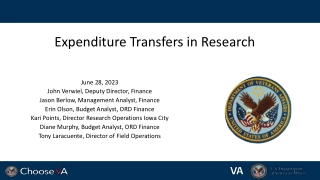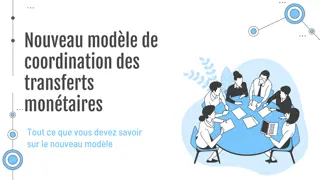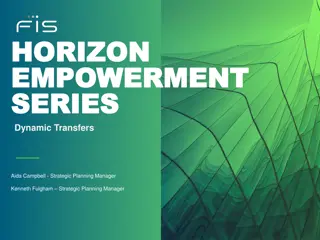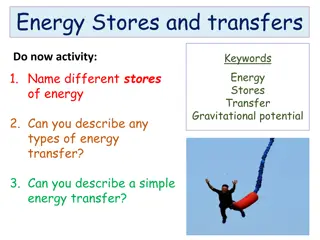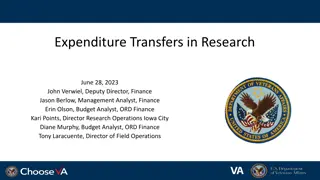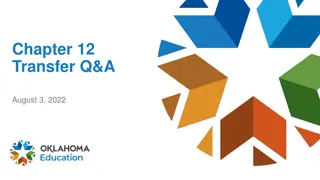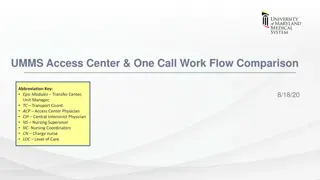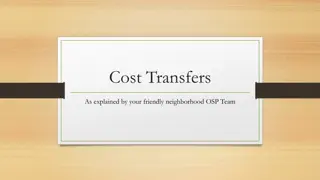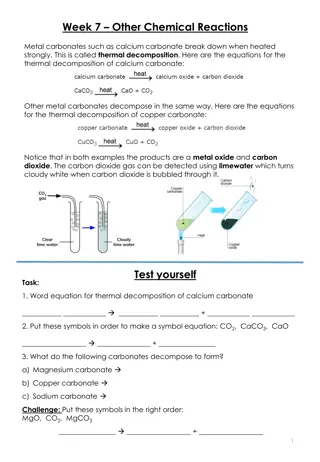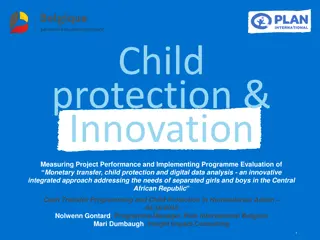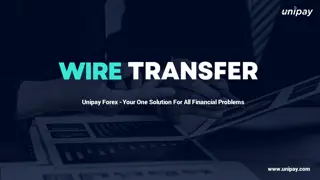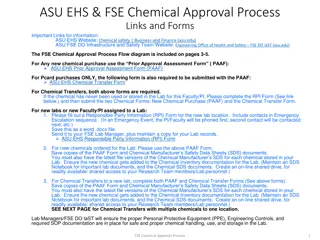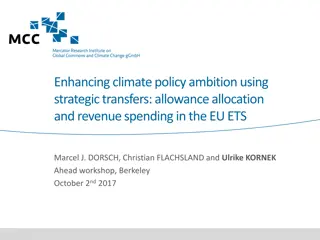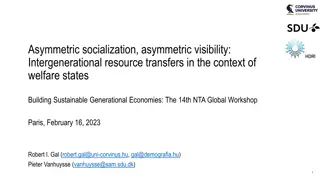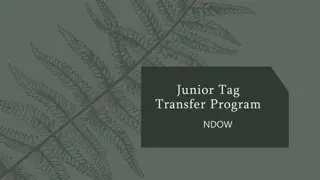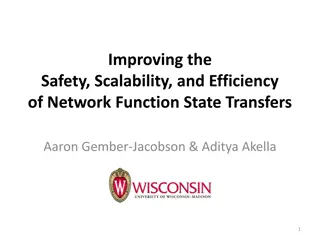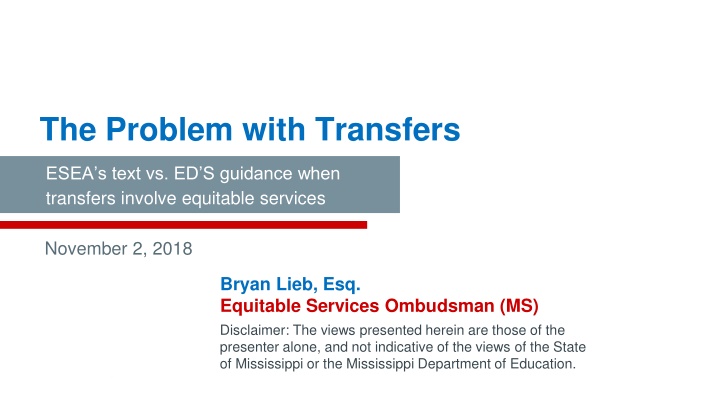
Challenges in Resolving Title V-A Transfers Involving Equitable Services
Explore the discrepancies between ESEA statutes and ED's guidance regarding transfers involving equitable services, highlighting the adverse impact and the legal implications. Understand why reconciling this conflict is crucial for maintaining equity in education.
Download Presentation

Please find below an Image/Link to download the presentation.
The content on the website is provided AS IS for your information and personal use only. It may not be sold, licensed, or shared on other websites without obtaining consent from the author. If you encounter any issues during the download, it is possible that the publisher has removed the file from their server.
You are allowed to download the files provided on this website for personal or commercial use, subject to the condition that they are used lawfully. All files are the property of their respective owners.
The content on the website is provided AS IS for your information and personal use only. It may not be sold, licensed, or shared on other websites without obtaining consent from the author.
E N D
Presentation Transcript
The Problem with Transfers ESEA s text vs. ED S guidance when transfers involve equitable services November 2, 2018 Bryan Lieb, Esq. Equitable Services Ombudsman (MS) Disclaimer: The views presented herein are those of the presenter alone, and not indicative of the views of the State of Mississippi or the Mississippi Department of Education.
Introduction & Takeaways Goal: To present the brief shown at left. Takeaways: (1) How the ESEA statutes are consistent in resolving Title V-A transfers involving equitable services; (2) How ED s guidance on this topic contradicts these statutes with harmful effect; (3) What the law has to say about statutory interpretation; and (4) Why we should care (and what to do). I have emailed every Ombudsman a copy, and hope you ll read it in full. ONPE have their copies, as do members of ED s OGC. 2
Introduction Who am I to say? I ve been researching, collaborating with peers, writing and sending memos to ED about transfers involving equitable services since November 2017. I was not the first person to notice the contradiction between ED s guidance and the law. Colleen Brooks, the former Ombudsman from Colorado and a lawyer, may have raised the issue first, CO having long used set-aside of the equitable share prior to transfers (now forbidden by ED). As another Ombudsman / lawyer, I was drawn to the legal problem of untangling this conflict. 3
Introduction The new normal? The U.S. Department of Education s (ED s) new interpretation of Title V-A transferability creates a weapon for LEAs to convert equitable services funding to LEA use at the LEA s whim, denying private school participation in ESEA programs and poisoning the LEA private school relationship. Given numerous opportunities, no one at ED has ever denied this. 4
Introduction The new normal? ED s interpretation is expressed in its guidance. This guidance is, by its own terms, non-binding and does not create or impose new legal requirements. Nonetheless, all stakeholders look to the guidance as the reference of first resort. The guidance is often a helpful explanation of the statutory law. But on transfers involving equitable services, the guidance has gone wrong, with incredibly damaging consequences. 5
Introduction An adversarial maneuver Under ED s current guidance, an LEA is free to transfer all of its Title II-A and IV-A allocations, including the presumptive equitable shares (which ED forbids being left behind as a set-aside), into another program, for example I-A. Thus, a private school anticipating many thousands of dollars worth of II-A and IV-A equitable services can be left empty-handed, the funding converted to LEA use through this self-interested LEA maneuver. The private school might not participate in I-A, or might be sufficiently affluent to qualify for little or no I-A funding. The private school s only option is to complain (per 8501(c)(5) and (c)(6)) to the Ombudsman that the required 8501 consultation prior to the transfer was not meaningful and it has been treated inequitably. 6
Introduction Two untenable outcomes Asked point-blank on May 25, 2018 how to resolve this dispute when a set-aside of the equitable share has been forbidden and the SEA arguably lacks the statutory authority to deny an LEA transfer ED has, to this day, remained silent. If relief was available for the private school at this juncture, ED would presumably be leaping at the chance to tell us. When a choice between two untenable outcomes results from your interpretation, it s time to reassess. 7
The Brief: Statutory Interpretation To begin: How does the law resolve disagreements in statutory interpretation? Keep these principles in mind: When a statute s language is plain, the sole function of courts at least where the disposition required by the text is not absurd is to enforce it according to its terms. Sebelius v. Cloer, 569 U.S. 369 (2013). It is a basic principle of statutory construction that a specific statute controls over a general provision particularly when the two are interrelated and closely positioned HCS-Laundry v. United States, 450 U.S. 1 (1981). [I]t is a commonplace of statutory construction that the specific governs the general. That is particularly true where Congress has enacted a comprehensive scheme and has deliberately targeted specific problems with specific solutions. RadLAX Gateway Hotel v. Amalgamated Bank, 566 U.S. 639 (2012). A provision that may seem ambiguous in isolation is often clarified by the remainder of the statutory scheme because only one of the permissible meanings produces a substantive effect that is compatible with the rest of the law (citations omitted). United Sav. Assn. of Tex. v. Timbers of Inwood Forest Associates, Ltd., 484 U.S. 365 (1988) (emphasis added). 8
ESEAs consistent statutory text A. Binding Assurances An LEA must apply for its ESEA program allocations. In applying, the LEA provides required assurances, under ESEA 2102(b)(2)(E) and 4106(e)(2)(B) for the Title II-A and IV-A programs. The LEA assures that if granted the allocation it will comply with section 8501 (regarding participation by private school children and teachers). B. Section 8501(a)(1) s Core Requirement When the LEA receives its ESEA program allocations, 8501(a)(1) requires an LEA receiving financial assistance under a program to, after timely and meaningful consultation, provide equitable services that address private school needs under the program. (Consistent with the Assurances). 9
ESEAs consistent statutory text C. Sections 5103(e)(1) and 5103(e)(2): General Rule, Specific Exception Congress addresses the problem of equitable services entangled in a transfer. Section 5103(e) includes the Applicable Rules for a Title V-A transfer: ESEA 5103(e): APPLICABLE RULES. (1) IN GENERAL. Except as otherwise provided in this part, funds transferred under this section are subject to each of the rules and requirements applicable to the funds under the provision to which the transferred funds are transferred. (2) CONSULTATION. Each State educational agency or local educational agency that transfers funds under this section shall conduct consultations in accordance with section 8501, if such transfer transfers funds from a program that provides for the participation of students, teachers, or other educational personnel, from private schools. (emphasis added) Note the first clause of the general provision actually points out the exception otherwise provided in this part (Title V Part A), the exception being the specific procedure required by 5103(e)(2) when equitable services are involved in the transfer. Lacking this exception, 5103(e)(1) might be read to completely contradict and avoid the program assurances and the command of 8501(a)(1). But with 5103(e)(2), Congress maintains the consistency of its statutory framework. 10
ESEAs consistent statutory text D. Section 8501(c)(3): Timing is Important Consultations in accordance with section 8501 must occur prior to the transfer, and for good reason. ESEA 8501(c)(3) states: The consultation required by paragraph (1) [ 8501(c)(1)] shall occur before the agency, consortium, or entity makes any decision that affects the opportunities of eligible private school children, teachers, and other educational personnel to participate in programs under this Act, and shall continue throughout the implementation and assessment of activities under this section. (emphasis added) This pre-transfer timing is consistent with the LEA s assurances and with 8501(a)(1) s requirement that an LEA receiving financial assistance under a program must provide equitable services under the program. Contradiction would arise if the required 8501 consultations occurred post-transfer. If an LEA were permitted to first maneuver funding between ESEA programs, then at the LEA s whim, private school students and teachers could be stunningly denied the opportunity to participate in programs under the Act (for example if all Title II-A and IV-A funds were transferred to I-A), nullifying the statutory assurances and 8501(a)(1). The pre-transfer timing requirement for consultations in accordance with section 8501 eliminates the possibility of these directly contradictory and overtly adversarial results. 11
ESEAs consistent statutory text E. Section 8501 Consultations: Establishing the Equitable Services Plan Being obligated to conduct consultations in accordance with section 8501 prior to the transfer, what specifically is required of the LEA? Here is ESEA s sole definition, per 8501(c): 12
ESEAs consistent statutory text Consultation is how equitable services will be provided: ESEA 8501(c) is the statutory litany of plan creation, including: identifying services fitting student needs, how the services will be provided and assessed, the calculation method and amount of funds available for those services, and concluding with the private school s written affirmation and opportunity to complain if not treated equitably. Consistent with the LEA s assurances, 8501(a)(1), and 5103(e)(2) s specific instructions, the goal is reaching agreement on how to provide equitable services. Though on occasion there may be lingering items of disagreement as to how to provide the services under a given ESEA program, the question is never whether to provide such services. If whether was debatable, equitable services would be completely at the whim of the LEA. Every ESEA description of consultation is stated in terms of how, not whether, services will be provided: ESEA 1117(a)(1)(A): [The LEA] shall provide [eq. svs.]; ESEA 1117(b)(1): the goal of reaching agreement on how to provide [equitable services]; ESEA 8501(c)(1): To ensure timely and meaningful consultation [an LEA] shall consult with appropriate private school officials. Such agency and private school officials shall both have the goal of reaching agreement on how to provide equitable and effective programs for eligible private school children 13
ESEAs consistent statutory text This sole definition of 8501 consultation applies with or without the transfer scenario being in play. In either case, the process occurs start to finish, through to the written affirmation before any decision is taken by the LEA that would affect the private school s opportunity to participate in programs under the Act. During the consultation process, the transfer has not yet occurred, the program s funding allocation has not moved from the original program. Equitable share and resultant services are finalized, in lockstep consistency with every interrelated statute discussed above. 14
ESEAs consistent statutory text F. Set-Aside of the Intact Equitable Share; Satisfaction of Stakeholder Interests The private school s equitable proportion of the allocation designated for specific equitable services program use during the foregoing consultations is simply left intact (set aside). The LEA has completed its statutory obligation in accomplishing the 8501 consultations required by 5103(e)(2). The LEA is now free to transfer the allocation s remaining funds to suit the LEA s needs, if and when the LEA desires. Whether or when the LEA decides to transfer some or all of the remaining public-share amount of the allocation has absolutely no impact on the private school s intact equitable share and resulting services under the given ESEA program. This is the clear and internally consistent procedure described by the ESEA statutes: the statutory assurances, the core requirement of 8501(a)(1), the specific instructions of 5103(e)(2), the timing requirement of 8501(c)(3), and the definitional requirements of 8501 consultation. This process for Title V transfers involving equitable services satisfies the interests of all stakeholders: the LEA interest in funding flexibility, and the private school interest in receiving its proportional share of program-specific funding and services. In this environment, a cooperative partnership can take root and flourish. ( And they all lived happily ever after wait, what!? ) 15
EDs contradictory, destructive interpretation A. Transferability as Open Season on Equitable Services Under ED s interpretation, an LEA could transfer all of its Title II-A and IV-A allocations, denying a private school the opportunity to participate in those programs by moving that funding to a program to which equitable service does not apply (such as I-D or V-B), to a program in which the private school has few or no qualifying students (such as I-A (low-income) or III-A (ELs)), or to a program in which the private school does not desire to participate. The power to dictate the outcome is all on one side. With no set- aside of the intact equitable share allowed, a private school can be left empty-handed, or nearly so, with the transfer clawing back funding for LEA use. 16
EDs contradictory, destructive interpretation B. Total Reliance on a Partial Reading of the General Rule of 5103(e)(1) ED starts with the general rule of 5103(e)(1), but conspicuously never mentions the first clause, Except as otherwise provided in this part, and insists that because transferred funds take on the character of the program to which they are transferred, there is only the new program (where the funds have been transferred) and the old program (if any portion was not transferred), and an intact set-aside of the equitable share is prohibited (though nowhere in ESEA does this prohibition appear in text). C. Ignoring the Specific Exception to the General Rule ED then ignores that 5103(e)(2) is a specific exception for transfers involving equitable services (and continues ignoring that this exception is spectacularly pointed out by the first clause of 5103(e)(1)). Of 5103(e)(2), ED acknowledges only that consultation must occur prior to the transfer. 17
EDs contradictory, destructive interpretation D. Redefining Consultation to Ignore the Actual Steps of 8501(c) ED then conspicuously redefines conduct consultations in accordance with section 8501 into a mere notice from the LEA to the private school that the transfer is occurring, noting (correctly!) that the LEA does not need the private school s permission to conduct the transfer (but ignoring Congress s explicit solution to the problem: that equitable services must first be established through conduct[ing] consultations in accordance with section 8501 prior to the transfer. Nowhere in ESEA is the redefining of 8501 authorized, stated, or even implied but ED persists in this redefinition, apparently attempting to cover its baseless forbiddance of a stand-alone, set- aside equitable services program. E. Redefined, Consultation is now Whether, no longer How to Provide Equitable Services ED makes consultation a decision at the LEA s whim on whether to provide equitable services, not how to provide them. This invented interpretation is absolutely contradictory to, and destructive of, the statutory framework established by Congress for equitable services, including Congress s reasonable solution for the transfer scenario. 18
EDs contradictory, destructive interpretation F. More Illogical Invention At the National Title I Conference in February of 2018 (and reportedly elsewhere), ED throws in a from- thin-air pronouncement that because there are not any ESEA programs that consist only of services to private schools students, the ESEA therefore prohibits an LEA from retaining funds in a program solely to provide equitable services. This invented prohibition is nowhere to be found in the text of ESEA, and such a prohibition directly contradicts (as thoroughly discussed above) ESEA s specific instructions on how to handle a transfer involving equitable services, instructions consistent with every interrelated statute. ESEA cannot be read to forbid an outcome it gives explicit instructions for accomplishing. 19
Whos right? For many, ESEA speaks with a consistent and orderly voice on the process for handling equitable services in the transfer scenario. Per the United States Supreme Court, plain statutory language must be enforced according to its terms. If any real or imagined ambiguity exists: [I]t is a commonplace of statutory construction that the specific governs the general." That is particularly true where Congress has enacted a comprehensive scheme and has deliberately targeted specific problems with specific solutions. RadLAX Gateway Hotel v. Amalgamated Bank, 566 U.S. 639 (2012). Applied to our question, the specific 5103(e)(2) controls over the general 5103(e)(1), and the exception for handling equitable services must be given application, not ignored. The problem of what to do when equitable services are entangled in a transfer situation is solved by following the instructions of 5103(e)(2) and setting aside the equitable share in 8501 consultations with the private school, then transferring the remaining funding. A provision that may seem ambiguous in isolation is often clarified by the remainder of the statutory scheme because only one of the permissible meanings produces a substantive effect that is compatible with the rest of the law. United Sav. Assn. of Tex. v. Timbers of Inwood Forest Associates, Ltd., 484 U.S. 365 (1988) (emphasis added). Applied to our question, ED s interpretation, in dramatic conflict with multiple related statutes, must be abandoned in favor of the correct interpretation (set-aside) which is fully compatible with the rest of the law. 20
Whos right? Not only does ED s interpretation substantively conflict with the core equitable services requirements and protections of ESEA, but it also introduces a toxic, adversarial interaction where there should be a mindset of public-private cooperation. It s na ve to rely on LEA benevolence. If LEAs can get more money within the rules, they will inevitably do so at the expense of the party set up as a powerless adversary in a zero-sum game. The firm underpinnings of the law protect equitable services regardless of benevolence. These underpinnings must simply be recognized - allowing no possibility that an LEA can claw away equitable services funding for its own use. 21
Whats next? As Ombudsmen we are mandated by ESEA to monitor and enforce the equitable services provisions of the law, to be the voice and defender of these democratically enacted provisions. I believe we must advocate in an organized way for the correcting of ED s guidance. How to go about this, and what allies are at hand? 22
Bonus Slide Misrepresentation by imprecision Imprecision from: (ONPE s) Ombudsman Update, January 2018 Although an LEA is not required to obtain agreement from private school officials prior to a transfer of funds, the goal of consultation is agreement (see ESEA section 8501(c)(1)). Thus, we encourage LEAs to carefully consider the views of private school officials prior to making decisions regarding transfers. By engaging in timely and meaningful consultation and developing positive relationships with private school officials, an LEA can facilitate creation of a cooperative environment and minimize problems and complaints. Imprecision from: (US ED s) ESSA Flexibilities, October 2018 Please note that a district must engage in timely and meaningful consultation with appropriate private school officials before transferring funds (ESEA section 5103(e)(2)). Per the Title VIII Uniform Provisions (ESEA section 8501) governing the equitable services requirements of Title II-A and Title IV-A, the goal of consultation is agreement and the district must give due consideration to the views of private school representatives. Statutory text from: ESEA 8501(c)(1): [The LEA] and private school officials shall both have the goal of reaching agreement on how to provide equitable and effective programs for eligible private school children (emphasis added to all passages) 23
Summary in Five Slides Intro ESEA gives explicit instructions for a Title V-A transfer involving equitable services. These instructions are consistent with every other ESEA statute related to equitable services and transfers, and the statutory process prevents a competition but satisfies the interests of all stakeholders. The next slide will list these consistent instructions. ED s guidance contradicts the ESEA statutes when a transfer involves equitable services, ignoring the statutory exception for handling equitable services in a transfer situation, and brazenly redefining section 8501 consultation into whether, (instead of how ) an LEA will provide equitable services, shifting all power to the LEA to manipulate what becomes a adversarial competition for dollars with the powerless private school. We ll look at the contradictions. Courts have long issued legal decisions (case law) on the principles of statutory interpretation. What does the United States Supreme Court s case law on statutory interpretation tells us about today s dueling interpretations of transfers involving equitable services? 24
Summary in Five Slides ESEAs consistent statutes Program funding application statutory assurances: If granted, LEA promises to comply with equitable services reqs. 8501(a)(1): An LEA receiving financial assistance under a program must provide equitable services under the program. Title V-A: If a transfer is intended, 5103(e)(2) is the pointed-out exception to the general rule 5103(e)(1). If equitable services are involved in the transfer, the LEA shall conduct consultations in accordance with section 8501. 8501(c)(3): Consultation occurs prior to any decision that affects the opportunities of private schools to participate in programs under the Act. This means prior to the transfer, before money moves. Even ED acknowledges this timing. What are consultations in accordance with section 8501? See, 8501(c)(1) through (c)(6): the aspired-to agreement on how to provide equitable services, including amount of funds and how determined (no money has yet moved). On through to private school written affirmation and option to complain if necessary to resolve any lingering disagreement on how to provide equitable services. (Consistent with all of the above, there is no question of whether to provide equitable services.) The LEA has now completed its statutory obligation in accomplishing the 8501 consultations required by 5103(e)(2). The private school s equitable proportion of the allocation designated for specific equitable services program use during the foregoing consultations is intact, and set aside. The LEA is now free to transfer the allocation s remaining funds to suit the LEA s needs, if and when the LEA desires. Everything here is lock-step consistent. ED has broken this process. 25
Summary in Five Slides EDs guidance contradicts ESEA ED latches on to the general rule of 5103(e)(1), but conspicuously never mentions the first clause, Except as otherwise provided in this part, and insists that because transferred funds take on the character of the program to which they are transferred, there is only the new program (where the funds have been transferred) and the old program (if any portion was not transferred), and an intact set-aside of the equitable share is prohibited (though no such prohibition appears in ESEA). ED ignores that 5103(e)(2) is a specific exception for transfers involving equitable services (and ignores that this exception is pointed out by the first clause of 5103(e)(1)). Of 5103(e)(2), ED acknowledges only that consultation must occur prior to the transfer. But ED redefines 8501 consultation into a mere notice from the LEA to the private school that the transfer is occurring, noting (correctly!) that the LEA does not need the private school s permission to conduct the transfer (but ignoring Congress s explicit solution to the problem: that equitable services must first be established through conduct[ing] consultations in accordance with section 8501 prior to the transfer. ED redefines consultation as the LEA s final decision on whether to provide equitable services, not how to provide them. This invented interpretation is absolutely contradictory to, and destructive of, the statutory framework established by Congress for equitable services, including Congress s specific solution for the transfer scenario. ED s guidance has contradicted everything listed on the prior slide: the statutory assurances, the command of 8501(a)(1), the specific exception of 5103(e)(2) and the definitional, statutory requirements of consultations in accordance with section 8501. 26
Summary in Five Slides Applying statutory interpretation For many, ESEA speaks with a consistent and orderly voice on the process for handling equitable services in the transfer scenario. Per the United States Supreme Court, plain statutory language must be enforced according to its terms. If any real or imagined ambiguity exists, the law of statutory interpretation leads us to the correct solutions: [I]t is a commonplace of statutory construction that the specific governs the general." That is particularly true where Congress has enacted a comprehensive scheme and has deliberately targeted specific problems with specific solutions. RadLAX Gateway Hotel v. Amalgamated Bank, 566 U.S. 639 (2012). Applied to our question, the specific 5103(e)(2) controls over the general 5103(e)(1), and the exception for handling equitable services must be given application, not ignored. The problem of what to do when equitable services are entangled in a transfer situation is solved by following the instructions of 5103(e)(2) and setting aside the equitable share in 8501 consultations with the private school, then transferring the remaining funding. A provision that may seem ambiguous in isolation is often clarified by the remainder of the statutory scheme because only one of the permissible meanings produces a substantive effect that is compatible with the rest of the law. United Sav. Assn. of Tex. v. Timbers of Inwood Forest Associates, Ltd., 484 U.S. 365 (1988) (emphasis added). Applied to our question, ED s interpretation, in dramatic conflict with multiple related statutes, must be abandoned in favor of the correct interpretation (set-aside) which is fully compatible with the rest of the law. 27
Summary in Five Slides All stakeholders satisfied The set-aside method described by the law has the obvious benefits of satisfying not only the private school interest in receiving a due share of equitable services, but also the LEA interest in funding flexibility its funds not being stuck in an undesired program. Could Congress have intended to satisfy the interests of all stakeholders in this massively bipartisan law? ED s forbiddance of the set-aside and redefinition of section 8501 consultation in the transfer scenario creates a weapon for LEA conversion of equitable services funding to LEA use at the LEA s whim, poisoning the LEA- private school collaborative relationship and encouraging an LEA mindset of keeping the most dollars, rather than effectively honoring their ESEA obligations to private schools. Though private schools have the right to complain, and surely many will, the two choices left by ED s guidance are to either block the transfer (destroying funding flexibility), or allow the transfer (destroying equitable services). Both results are absurd and untenable. When two untenable choices arise at the end of your journey, you must reexamine how you arrived there. ED s indefensible transferability guidance must be abandoned in favor of the set-aside method required by law. Ombudsmen should mobilize to achieve this outcome. 28

